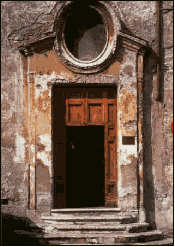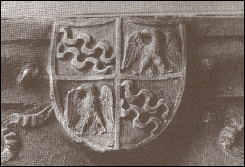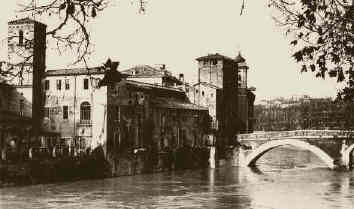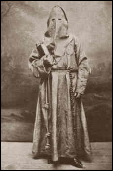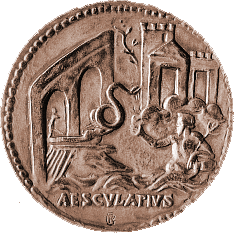
Monuments
Palazzo Pierleoni Caetani the church of San Bartolomeo all'Isola and the church of San Giovanni Calibita are the three most important monuments on Tiber Island. The Palazzo Pierleoni Caetani is of particular interest to the Tiber Island History Museum Association as it was designated to become the museum of the history of the Island. In itself its stones are like a review of the two thousands years of Roman history and as a classified national monument in the center of Rome it belongs to the Patrimony of Humanity established by UNESCO.
The building stands between the church of San Bartolomeo all'isola, the piazza of the same name and the Via Communis, the ancient name for the street connecting the bridges over the Tiber, called Pons Fabricius (now Ponte Fabricio) and Pons Cestius (now Ponte Cestio).
The tower known as the Torre Caetani built around the 11th century, commands the Ponte Fabricio, one the main accesses to Rome of the time, and served military and customs-collection purposes. The tower has also been known as the Torre della Pulzella ("Tower of the Damsel") after a marble head inserted in the masonry. Another name among the Romans was Torre della Contessa ("Tower of the Countess") referring to Countess Matilde of Tuscany who resided in the palace several times during the 11th century.The palace was the residence of the Pierleoni family until the 13th century. In their third generation, after conversion from Judaism, the family produced a pope, Anacletus II, who reigned from 1130 to 1138. Contested by another Pope, Innocent II, at his death he was relegated to the list of antipopes. The Caetani family acquired the palace and remained there until 1557 when a flood devastated the Island and they moved to another seat in the center of the city.
In 1639 Cardinal Barberini bought the edifice, restored and donated it to the Franciscan Order of the Friars Minor who specialized in assisting the sick.
In 1658, during an epidemic of plague in Rome the building and other structures on the Island served as quarantine station (the Lazzaretto Brutto).
In the second half of the18th century the Confraternity of the Devotees of Jesus at Calvary installed their Oratory in the ground floor of Palazzo Pierleoni Caetani and arranged a cemetery in the basement, for their members and for persons who drowned in the Tiber.The Oratory and the cemetery may be visited on request.
After Rome was wrested from the Pope by national troops in 1870 and became the capital of united Italy, many church properties were expropriated including the Palazzo Pierleoni Caetani. The building passed to the City of Rome, except for a portion of its ground floor and mezzanine, alienated by the Franciscan monks in the 18th century, which remained private property.
In the 1891 the City let the upper floors of the building and the tower to the Jewish Hospital for ninety years. Before the end of the concession this institution moved to a new building in the suburb of la Magliana.From 1957 to 1963 the Rome- New York Art Foundation was installed on the ground floor of the palace, at number 20 Piazza San Bartolomeo all'Isola. Founded by Frances McAnn with Peggy Guggenheim, Herbert Read and James Johnson Sweeney as patrons, it was one of the most important art centers in postwar Italy, and showed for the first time in Rome leading contemporary artists such as Jackson Pollock, Henry Moore, Barnett Newman and Sam Francis among many others.
|
|
||||
|
|
